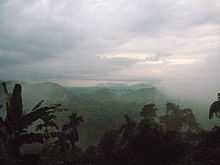Fa Hien Cave
Pahiyangala Cave is a cave in the district of Kalutara, Western Province, Sri Lanka, according to a village legend named after the Buddhist monk Faxian (Wade-Giles: Fa Hsien). However, there is no archeological or historical evidence to support this legend. The cave is important for the Late Pleistocene human skeletal remains discovered there in the 1960s and 1980s.
Human Prehistoric remains
The first human burials in the cave were uncovered in 1968 by Dr Siran U. Deraniyagala (of the Sri Lankan government department of archaeology), who returned with an assistant, W. H. Wijepala, in 1988. The main finds consisted of microliths, the remains of ancient fires, and the remains of plants and human beings. Radiocarbon dating indicated that the cave had been occupied from about 33,000 to 4,750 years ago — from the Late Pleistocene to the Middle Holocene. The human remains from the different levels were taken to the Human Biology Laboratory at Cornell University, where they were studied by Dr Kenneth A. R. Kennedy and one of his graduate students, Joanne L. Zahorsky.[1]
The oldest fragments of human bone came from a young child, two older children, a juvenile, and two adults, and showed evidence of being secondary burials: that is, after death, the bodies were exposed, and after decomposition and the predations of scavengers, the bones were placed in graves. The later remains included those of a young child, about 6,850 years old, and a young woman (nicknamed Kalu-Menika by the archaeologists), about 5,400 years old. Both were also secondary burials.
The discoveries were important to archaeologists and palaeontologists because the earliest of the people buried in Pahiyangala Cave lived at the same time as European Cro-Magnon man and other hominids of the Late Pleistocene around the world. Studies of the teeth found in the cave indicate that the population of Sri Lanka ground nuts, seeds, and grains in stone querns in the preparation of food, and that they continued to live as hunter-gatherers until about the 8th century BCE. Sri Lanka has yielded the earliest known microliths, which didn't appear in Europe until the Early Holocene.[2]
Other important Sri Lankan prehistoric sites at which human remains have been found include two other caves – Batadombalena (about 28,500 years old) and Belilena Kitulgala (about 12,000 years old) – and an open-air site, Bellanbandi Palassa (about 6,000 years old).

See also
Sources
- Kenneth A. R. Kennedy, "Fa Hien Cave", in Encyclopedia of Anthropology ed. H. James Birx (2006, SAGE Publications; ISBN 0-7619-3029-9)
- "Pre- and Protohistoric settlement in Sri Lanka" — S. U. Deraniyagala, Director-General of Archaeology, Sri Lanka
- Kenneth A. R. Kennedy and Siran U. Deraniyagala, Fossil remains of 28,000-year old hominids from Sri Lanka, Current Anthropology, Vol. 30, No. 3. (Jun., 1989), pp. 394–399.
- Kenneth A. R. Kennedy, T. Disotell, W. J. Roertgen, J. Chiment and J. Sherry, Biological anthropology of upper Pleistocene hominids from Sri Lanka: Batadomba Lena and Beli Lena caves, Ancient Ceylon 6: 165-265.
- Kenneth A. R. Kennedy, Siran U. Deraniyagala, W. J. Roertgen, J. Chiment and T. Disotell, Upper Pleistocene fossil hominids from Sri Lanka, American Journal of Physical Anthropology, 72: 441-461, 1987.
References
- ↑ The Travels of Pahiyangala. Lakvida.com. Accessed May 19, 2012.
- ↑ Pre- and Protohistoric Settlement in Sri Lanka. LankaLibrary.com. Accessed May 19, 2012.